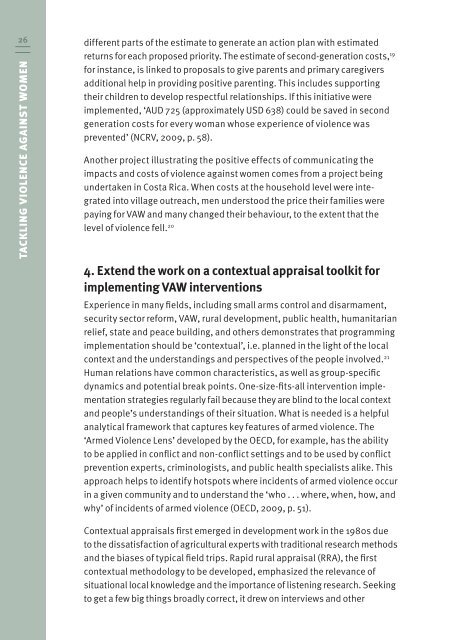Tackling Violence against Women: From Knowledge to Practical
Tackling Violence against Women: From Knowledge to Practical
Tackling Violence against Women: From Knowledge to Practical
You also want an ePaper? Increase the reach of your titles
YUMPU automatically turns print PDFs into web optimized ePapers that Google loves.
26 different parts of the estimate <strong>to</strong> generate an action plan with estimated<br />
returns for each proposed priority. The estimate of second-generation costs, 19<br />
for instance, is linked <strong>to</strong> proposals <strong>to</strong> give parents and primary caregivers<br />
additional help in providing positive parenting. This includes supporting<br />
their children <strong>to</strong> develop respectful relationships. If this initiative were<br />
implemented, ‘AUD 725 (approximately USD 638) could be saved in second<br />
generation costs for every woman whose experience of violence was<br />
prevented’ (NCRV, 2009, p. 58).<br />
TAckliNG ViolENcE AGAiNsT WomEN<br />
Another project illustrating the positive effects of communicating the<br />
impacts and costs of violence <strong>against</strong> women comes from a project being<br />
undertaken in Costa Rica. when costs at the household level were integrated<br />
in<strong>to</strong> village outreach, men unders<strong>to</strong>od the price their families were<br />
paying for VAw and many changed their behaviour, <strong>to</strong> the extent that the<br />
level of violence fell. 20<br />
4� Extend the work on a contextual appraisal <strong>to</strong>olkit for<br />
implementing VaW interventions<br />
Experience in many fields, including small arms control and disarmament,<br />
security sec<strong>to</strong>r reform, VAw, rural development, public health, humanitarian<br />
relief, state and peace building, and others demonstrates that programming<br />
implementation should be ‘contextual’, i.e. planned in the light of the local<br />
context and the understandings and perspectives of the people involved. 21<br />
Human relations have common characteristics, as well as group-specific<br />
dynamics and potential break points. One-size-fits-all intervention implementation<br />
strategies regularly fail because they are blind <strong>to</strong> the local context<br />
and people’s understandings of their situation. what is needed is a helpful<br />
analytical framework that captures key features of armed violence. The<br />
‘Armed <strong>Violence</strong> Lens’ developed by the OECD, for example, has the ability<br />
<strong>to</strong> be applied in conflict and non-conflict settings and <strong>to</strong> be used by conflict<br />
prevention experts, criminologists, and public health specialists alike. This<br />
approach helps <strong>to</strong> identify hotspots where incidents of armed violence occur<br />
in a given community and <strong>to</strong> understand the ‘who . . . where, when, how, and<br />
why’ of incidents of armed violence (OECD, 2009, p. 51).<br />
Contextual appraisals first emerged in development work in the 1980s due<br />
<strong>to</strong> the dissatisfaction of agricultural experts with traditional research methods<br />
and the biases of typical field trips. Rapid rural appraisal (RRA), the first<br />
contextual methodology <strong>to</strong> be developed, emphasized the relevance of<br />
situational local knowledge and the importance of listening research. Seeking<br />
<strong>to</strong> get a few big things broadly correct, it drew on interviews and other









